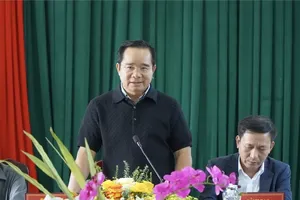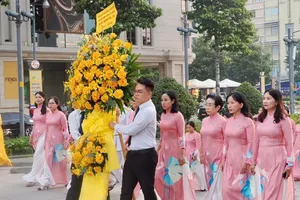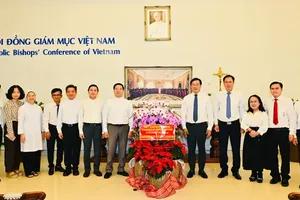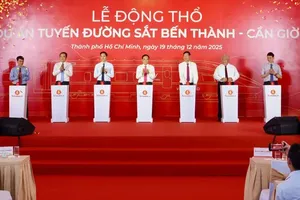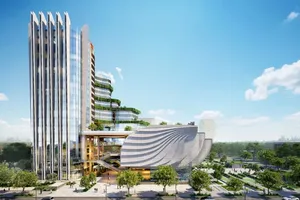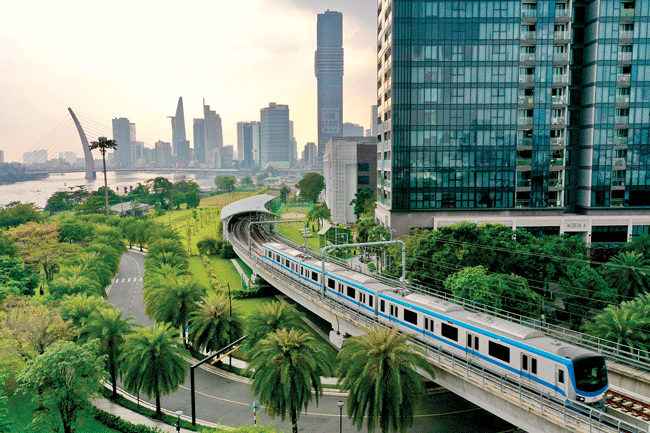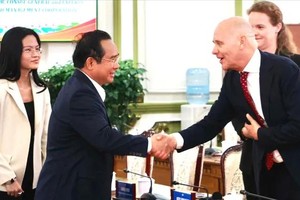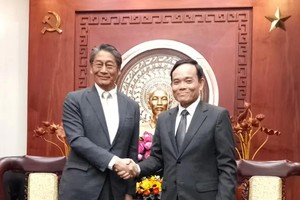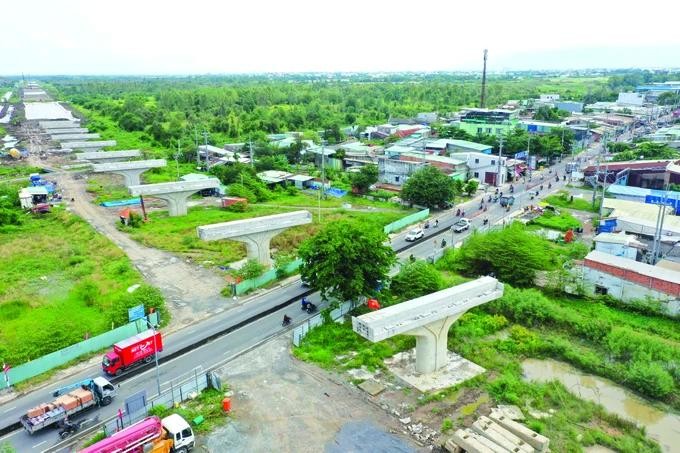
These are the Ring Road 4 Project, the Urban Railway Development Project of Ho Chi Minh City and the Project to build an International Financial Center in Ho Chi Minh City with specific mechanisms and policies applied to each project, with the expectation of removing institutional obstacles to complete infrastructure and develop the socio-economy.
The National Highway 13 via Thu Duc City is a major traffic route connecting Ho Chi Minh City to Binh Duong Province and the Central Highlands, and it is sometimes crowded during rush hour.
Resident Doan Thi Thanh Huong in District 12 said that this route is heavily trafficked by passenger cars and motorbikes, yet the narrow road surface frequently leads to traffic jams, causing significant frustration for commuters.
It is hopeful that the difficulties faced by Ms. Huong and other drivers will be soon removed by the upcoming resolution as the city is set to invest in the modernization and expansion of the National Highway 13 through a build-operate-transfer (BOT) contract as per the guidelines outlined in the National Assembly’s Resolution No. 98/2023/QH15 which paves the way for the development of Ho Chi Minh City by introducing a range of specific mechanisms and policies.
It is expected that this route will be expanded to 53-60m, with a scale of 6-8 lanes, with a total investment of nearly VND14,000 billion. The city is currently undergoing pre-feasibility studies for the project. The pre-feasibility report will be submitted to the HCMC People's Council for approval of the investment policy in the fourth quarter of 2024 sot that the project construction can start in early 2025.
Director of the Ho Chi Minh City Department of Transport Tran Quang Lam announced that in addition to the National Highway 13, four other routes will also be expanded through BOT contracts under the framework of the Resolution 98. These routes include National Highway 1, National Highway 22, the North-South axis road, and Binh Tien bridge and road.
Upon the completion of these projects, coupled with expressways and ring roads, Ho Chi Minh City will essentially establish a state-of-the-art backbone transportation network. This infrastructure development will contribute to smoother traffic flow, alleviate congestion, and enhance connectivity between the city and neighboring provinces.
At an online meeting with relevant ministries, agencies and localities on the implementation of the investment project to build the Ring Road 4 in Ho Chi Minh City on October 1, Deputy Prime Minister Tran Hong Ha requested the Ministry of Transport to coordinate with localities to unify and propose mechanisms, policies and specific features applicable to the project. The Deputy Prime Minister also urged the southern metropolis to work with other localities upon pre-feasible study report of the project as per public-private partnership model. The study report should be submitted to the State Appraisal Council in November 2024.
The Politburo’s Resolution No. 31 outlines the vision for Ho Chi Minh City as the central hub of the Southeast region and a key growth driver for the entire nation, aiming to attract financial institutions and international economic entities. Among the proposed tasks and solutions is the planning for the development of underground spaces, green areas in the city center, and new urban zones surrounding metro stations, all in line with an urban development model that integrates Transit Oriented Development (TOD).
Ho Chi Minh City is actively working on the implementation and establishment of projects and plans for transportation development. Notably, the urban railway (metro) project aims to complete a total of 183 kilometers of metro lines by 2035, which will consist of six lines and 148 stations, with an estimated initial investment exceeding VND 824 trillion at this stage.
To achieve this goal, the southern largest city needs to implement robust mechanisms. Architect Ngo Viet Nam Son, a member of the Advisory Council for the Resolution 98, recommends granting Ho Chi Minh City the authority to auction land use rights for TOD development and allocate all proceeds directly to metro projects.
Additionally, the city should issue bonds to encourage the private sector in metro development. The National Assembly's approach of implementing tailored mechanisms and policies for individual large projects has demonstrated notable effectiveness.
In fact, the National Assembly's issuance of specific mechanisms and policies applicable to each large project has shown clear effectiveness. Typically, with the Ho Chi Minh City Ring Road 3 project, the National Assembly allowed the Chairman of the People's Committee of the province or city to exercise the authority of the person deciding on investment in the component projects.
As a result, all component projects have been executed on time, particularly the compensation and site clearance activities. To date, the total area of land recovered has reached 95 percent. This project received approval from the National Assembly via the bidding process, which included consulting packages and those related to compensation, support, and resettlement for the component projects.
Local administrators said that the new resolution has helped to shorten the preparation time contributing to speed up the progress.
Based on the effectiveness of the specific mechanisms and policies for executing the Ring Road 3 project, the People's Committee of Ho Chi Minh City and the People's Committees of the provinces of Ba Ria - Vung Tau, Dong Nai, Binh Duong, Long An have reached an agreement to propose to the National Assembly the establishment of specific mechanisms and policies for the implementation of the Ring Road 4 project.
These mechanisms will be similar to those utilized for the Ring Road 3 project. Ho Chi Minh City also intends to present to the National Assembly a project to establish an International Financial Center in Ho Chi Minh City with ten policy mechanisms concentrating on key groups of competitiveness pillars. These are the policy tools for the development of the financial sector, enhancing the business environment, and managing human resources.
HCMC plans to release bonds to fund the development of urban railway infrastructure
The urban railway development initiative is guided by the Politburo’s Conclusion 49 which mandates that both Ho Chi Minh City and Hanoi should have largely completed their urban railway systems by 2035. Currently, Ho Chi Minh City has metro line No. 1, spanning approximately 20 kilometers, with plans to expand this by an additional 183 kilometers by 2035, requiring an estimated investment of around USD$36 billion. Between now and 2030, the city aims to construct about 31 kilometers of new lines, with construction expected to accelerate post-2030 once preparatory work is finalized.
To finance this project, the city plans to issue urban railway bonds and utilize land resources surrounding the metro lines. Additionally, Ho Chi Minh City aims to commence construction on the remaining sections of the Ring Road 2 project in 2025 to ensure its completion. The Ring Road 3 project is progressing as per the National Assembly's Resolution, with an anticipated opening for traffic in early 2026 and full completion expected by the second quarter of that year. Furthermore, Ho Chi Minh City has been designated as the lead agency for the preparation and submission of the Ring Road 4 project.
The localities which the Ring Road 4 passes through have arrived at an agreement that the project will include two key components - site clearance and construction. For the site clearance aspect, we suggest that the Central Government provide 50 percent support to the provinces of Ba Ria - Vung Tau, Dong Nai, and Binh Duong, with the remaining 50 percent covered by the provincial budgets. Ho Chi Minh City will manage its own funding, while Long An Province, facing challenges in budget collection, has requested a 75 percent contribution from the Central Government.
Regarding the construction component, city leaders planned to utilize public-private partnership (PPP) and Build-Operate-Transfer (BOT) contract models, which will limit state budget involvement to a maximum of 70 percent, requiring at least 30 percent investment from private investors. The goal is to present this proposal to the National Assembly during the upcoming session at the end of this year, with the aim of commencing construction in 2025 and completing it by 2027.





